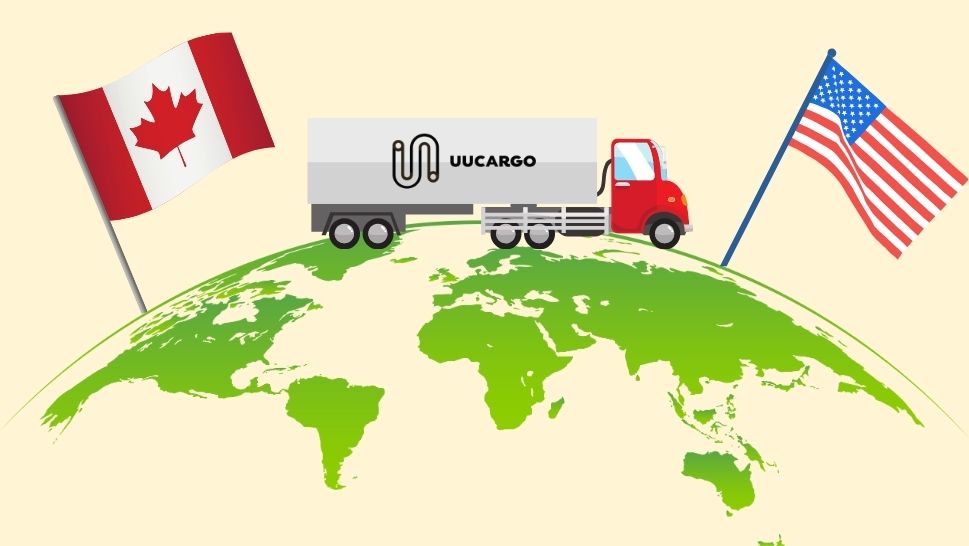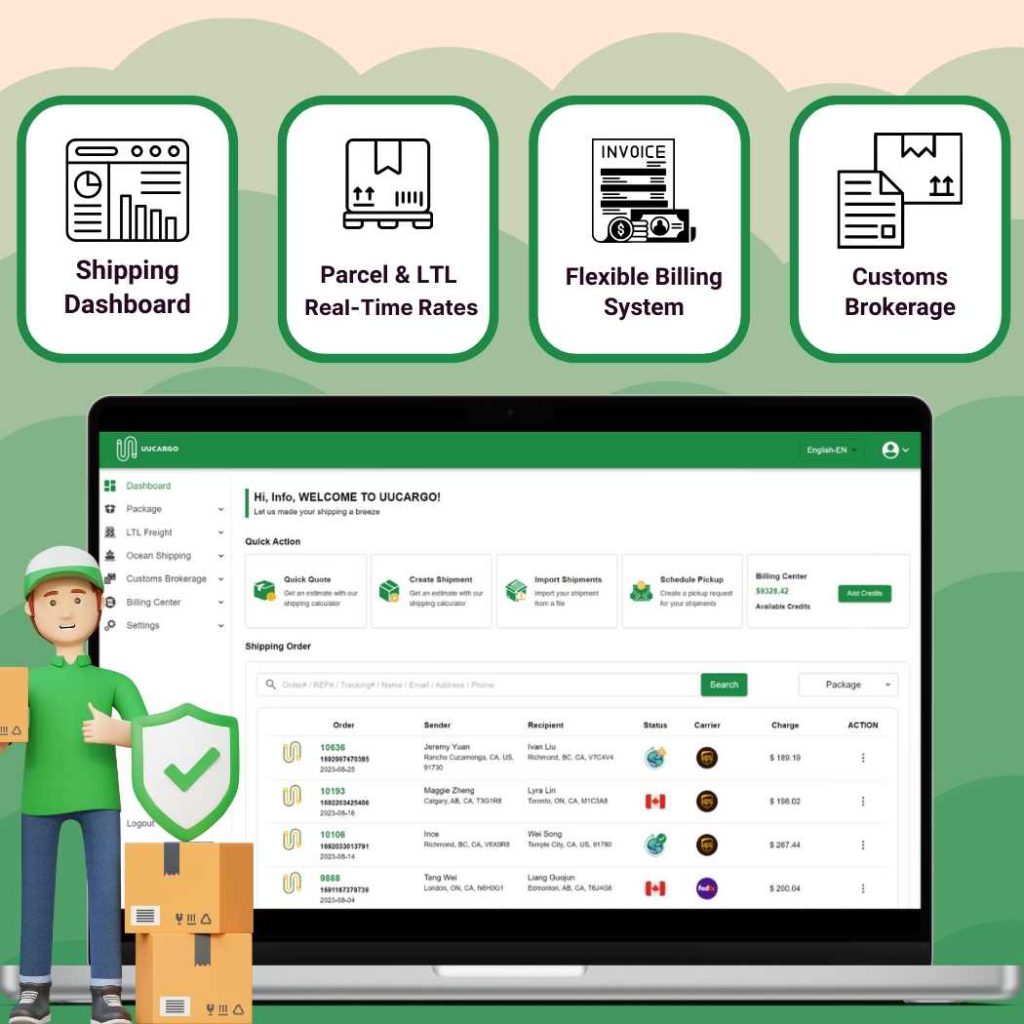The economic interdependence between Canada and the United States is monumental, underscored by the staggering trade volumes between the two nations. In October 2023, Canada’s exports to the United States reached C$48.8 billion, with imports at C$31.3 billion, showcasing the United States as Canada’s most significant trading partner, second only to Mexico.
The recent updates to the United States-Mexico-Canada Agreement (USMCA) and a shift towards nearshoring strategies are poised to enhance this trade relationship further. Approximately 30,000 trucks cross the Canada-U.S. border daily, navigating through complex customs processes and regulations.
This guide is designed to navigate the intricacies of cross-border shipping between Canada and the USA, aiming to simplify the process and promote seamless international trade.
Table of Contents
Learn About the Cross-Border Shipping Process
Embarking on cross-border shipping from Canada to the USA requires a comprehensive understanding of the international shipping landscape, including import taxes, restrictions, timeframes, and costs.
Import Taxes
One critical aspect of cross-border shipping is the U.S. government’s potential imposition of import taxes or duties. These taxes are determined based on the product’s value, type, and origin. We have established strong partnerships with reliable customs clearance agencies to help our customers succeed during their cross-border shipping. The following two companies are our partners:
Fortunately, the USMCA facilitates a smoother trade process, covering most products and often exempting them from such taxes, thereby promoting free trade across North American borders.
Restrictions

Navigating product restrictions is another essential consideration. Certain items, such as firearms, pharmaceuticals, and specific agricultural products, face strict regulations and may require special permits or documentation. Being well-versed in these regulations is crucial to avoid delays or confiscations at the border.
Time Frames and Estimated Costs
Shipping timelines and costs can vary significantly based on the chosen courier service and the distance between the origin and destination. For example:
- Shipping from Toronto to Miami: Small package delivery through courier services typically ranges from 2-5 business days, with costs estimated between $20 to $50.
- Shipping from Toronto to New York: Expect a delivery timeframe of 1-3 business days for small packages, with the cost ranging from $15 to $40.
- Shipping from Vancouver to New York: Due to the increased distance, small packages may take 3-7 business days to arrive, with costs ranging from $30 to $60.
Understanding these aspects can help shippers choose the right shipping method that balances cost efficiency and delivery speed.
Choose the Right Shipping Partner and Shipping Method
Selecting a reliable shipping partner is paramount for successful cross-border logistics. Major couriers such as UPS, FedEx, DHL, and Canada Post offer various services tailored to different needs. For instance, comparing the estimated shipping time and cost from Toronto to New York for a small package (5lbs) across these couriers can highlight the best option for your requirements.
Furthermore, leveraging a cross-border Third-Party Logistics provider (3PL) like UUCargo can significantly enhance your shipping strategy. UUCargo specializes in providing competitive rates for Less Than Truckload (LTL) and courier services, ensuring cost-effective and efficient delivery across the border.

Paperwork You'll Need to Ship Cross-Border Truckload
The complexity of cross-border shipping is partly due to the extensive documentation required for customs clearance. Essential documents include:
Bill of Lading (BOL)
The BOL acts as a contract between the freight carrier and the shipper, outlining the shipment details necessary for processing and invoicing. This includes the shipper’s and receiver’s contact information, as well as a detailed description of the goods being transported.
Commercial Invoice
Certification of Origin
Under the USMCA, a Certificate of Origin is required to qualify for preferential tariff treatment, verifying the goods’ origin. This certificate can now be completed and signed electronically, offering greater flexibility.
Working with an experienced customs broker can ensure all documentation is accurately prepared, facilitating a smooth customs clearance process.
What Is a Tariff Code / Harmonized System?
A tariff code, as defined by the Harmonized System (HS), is a standardized numerical method for classifying traded products used globally by customs authorities. The HS code is crucial for determining duties and taxes and collecting trade statistics. Understanding both the U.S. and Canadian tariff codes for your products is essential for compliance and efficient customs processing.
Determine the Size and Weight of your Package
The Cheapest Way to Ship From Canada to the USA
When it comes to shipping from Canada to the USA, finding the most cost-effective method is crucial for businesses looking to maximize their logistics efficiency while minimizing expenses. There are several strategies that can help achieve this goal, ensuring that your shipments are not only affordable but also reliable and timely. Here are some key approaches to consider:
Small Parcel Shipping
For businesses shipping smaller items, small parcel shipping stands out as the most budget-friendly option. This method is perfect for packages weighing less than 70 pounds and offers a balance between cost and speed. Shipping providers like UPS, FedEx, DHL, and Canada Post are equipped to handle these shipments efficiently, leveraging ground shipping networks to offer competitive rates. This approach is especially beneficial for businesses aiming to keep shipping costs low while still providing quick delivery times to their American customers.
LTL Carriers
Less-than-truckload (LTL) shipping is an excellent strategy for businesses with shipments that don’t fill an entire truck. LTL allows for the consolidation of freight from multiple shippers into a single truckload, making it a cost-effective choice for transporting goods from Canada to the US. This method reduces shipping costs by sharing the total transportation expenses among all shippers involved. It’s an ideal solution for small to medium-sized enterprises (SMEs) looking for a balance between cost and efficiency in their cross-border shipping operations.
UUCargo's Platform
Find the Cheapest Rates
Bottom Line
Navigating cross-border shipping from Canada to the USA demands a thorough understanding of logistics, customs regulations, and paperwork. By choosing the right shipping partner, like UUCargo, and being prepared with the correct documentation and knowledge of shipping processes, businesses can ensure efficient and cost-effective deliveries, fostering growth and customer satisfaction across borders.




